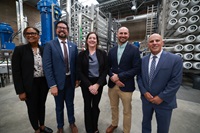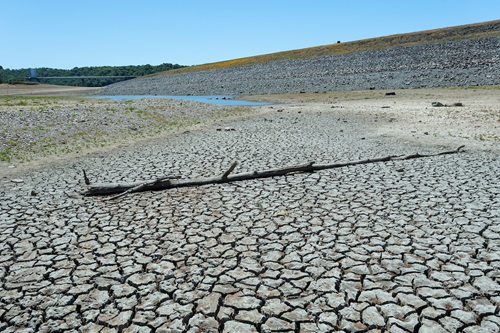Following several years of planning and investment, the City of Antioch has reached a climate-resilient milestone: a new brackish water desalination facility near its existing water treatment plant.


Dry conditions in the area of Lake Mendocino in Mendocino County. DWR/2021.
California is no stranger to drought; it is a recurring feature of our climate. We recently experienced the 5-year event of 2012-2016, and other notable historical droughts included 2007-09, 1987-92, 1976-77, and off-and-on dry conditions spanning more than a decade in the 1920s and 1930s.
Paleoclimate records going back more than 1,000 years show many more significant dry periods. The dry conditions of the 1920s-30s, however, were on a par with the largest 10-year droughts in the much longer paleoclimate record.
Droughts cause public health and safety impacts, as well as economic and environmental impacts. Public health and safety impacts are primarily associated with catastrophic wildfire risks and drinking water shortage risks for small water systems in rural areas and private residential wells. Examples of other impacts include costs to homeowners due to loss of residential landscaping, degradation of urban environments due to loss of landscaping, agricultural land fallowing and associated job loss, degradation of fishery habitat, and tree mortality with damage to forest ecosystems.
Unfortunately, the scientific skill to predict when droughts will occur – which involves being able to forecast precipitation weeks to months ahead – is currently lacking. Improving long-range weather modeling capabilities is an area of much-needed research.
Defining drought is based on impacts to water users. California is a big state and impacts vary with location. Hydrologic conditions causing impacts for water users in one location may not represent drought for water users in a different part of California, or for users with a different water supply. Individual water agencies may use criteria such as rainfall/runoff, amount of water in storage, or expected supply from a water wholesaler to define their water supply conditions.
Drought is a gradual phenomenon, occurring slowly over a period of time. Storage, whether in surface water reservoirs or in groundwater basins, buffers drought impacts and influences the timing of when drought impacts occur. A single dry year isn’t a drought for most Californians because of the state’s extensive system of water infrastructure and groundwater resources buffer impacts.
Drought impacts are felt first by people most dependent on annual rainfall – such as ranchers using dryland range or rural residents relying on wells in low-yield rock formations. Drought impacts increase with the length of a drought, as carry-over supplies in reservoirs are depleted and water levels in groundwater basins decline.
Provisions of California’s Emergency Services Act have been used to declare a statewide drought emergency for only two of our droughts, the 2012 to 2016 event and its immediate predecessor in 2007-09.
Current Water Conditions in California
Percent of Average Precipitation Water Year to Date
Departure from Average Temperature Water Year to Date
Comparison of Current Water Year Natural Flow to Drought WYs 2014 & 2015
Central Valley Project Water Allocations (Historical and Present)
State Water Project Allocations (Historical and Present)
Colorado River Reservoir Conditions, Lower Basin
Colorado River Reservoir Conditions, Upper Basin
On March 28, 2022, the Governor issued Executive Order N-7-22, which included the suspension under specific circumstances of the California Environmental Quality Act, also known as CEQA (Public Resources Code, Division 13 (commencing with section 21000)).
To qualify for the CEQA suspension, projects had to be consistent with Executive Order Action 13 requirements. Groundwater recharge projects had to occur on open and/or working lands, be funded by the Sustainable Groundwater Management Grant Program or be designated a Flood-Managed Aquifer Recharge project, and needed to offset or mitigate drought impacts on groundwater. Local agencies implementing recharge projects and seeking CEQA suspension were required to submit a Self-Certification Form to DWR for review and concurrence that the proposed activities were eligible under the Executive Order provisions.
See below for the list of projects that have received DWR concurrence for eligibility for the CEQA suspension, as directed by the Executive Order.
In light of improved hydrologic conditions, self-certification forms for DWR concurrence are no longer being accepted for this Executive Order CEQA suspension. We encourage you to explore statutory and/or categorical exemptions under CEQA that may be applicable to your project.
The following are the Approved Suspension Requests:
The State Water Resources Control Board has regulatory authority to review and approve all water rights permit applications, including the 180-day temporary water rights permits for groundwater recharge. DWR, in our assistance role, is working with GSAs that have identified applicable local groundwater recharge projects to facilitate the water rights permitting process. These projects are consistent with the Sustainable Groundwater Management Act (SGMA) and drought recovery strategies in the Governor’s “California Water Supply Strategy, Adapting to a Hotter, Drier Future.”
For more information on available regulatory assistance and eligibility, see our fact sheet on DWR’s regulatory assistance for temporary water rights for groundwater recharge.
California's Water Supply Strategy: Adopting to a Hotter, Drier Future
Report to the Legislature on the 2012-2016 Drought
California's Drought of 2012-2016: An Overview
Drought in California Brochure
California’s Most Significant Droughts
California Data Exchange Center
Western Regional Climate Center
State Water Board Drought Year Water Actions
California’s Drought of 2007-2009: An Overview
Preparing for California’s Next Drought: Changes Since 1987-92
1976-77 California Drought: A Review
Water Year 2018: Hot and Dry Conditions Return
Water Year 2017: What a Difference a Year Makes

Following several years of planning and investment, the City of Antioch has reached a climate-resilient milestone: a new brackish water desalination facility near its existing water treatment plant.
Notice is hereby given that the California Department of Water Resources (DWR), as the Lead Agency of the Drought Resilience Interagency & Partners (DRIP) Collaborative, will host a series of workgroup meetings of the DRIP Collaborative in June 2025.
.jpg?mw=200&hash=A9DDD57FA5AE105D2BB219BEB7FC6276)
You may have heard of the term subsidence but what does it mean? Subsidence is the sinking of land which can be caused by various factors including groundwater pumping. In California, subsidence has been documented for over a century and is a growing issue that impacts our water infrastructure and the communities who rely on it.